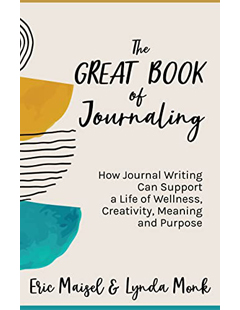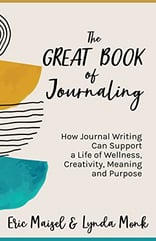This review originally appeared on https://maryannmoore.ca and then re-published on https://iajw.org. It is re-published here with permission. Mari L. McCarthy contributed to The Great Book of Journaling
Eric Maisel who has written over 50 books on writing, creativity and such topics as establishing your own daily practice, and Lynda Monk, writer and director of the International Association for Journal Writing (IAJW), have gathered an exciting array of contributors for The Great Book of Journaling offering a myriad of innovative approaches to a personal writing practice.
Both Eric and Lynda have contributed chapters to the book. Eric’s is “From Journal to Memoir” which will interest many readers as they think about what to do with their accumulation of journals.
Lynda’s is “The Reflective Journal” in which she outlines “The 5 Steps of Life Source Writing” which she created for “self-care, self-discovery, creativity, and wellness.” Lynda regularly teaches, speaks, and writes on the healing power of personal writing.
The sub-title of the book is “How Journal Writing Can Support a Life of Wellness, Creativity, Meaning and Purpose.” A tall order and I believe the book fulfills its intent. Published by Mango this summer, The Great Book of Journaling features essays by forty of the top journal experts in the world including SARK, Kathleen Adams, Judy Reeves, and Lucia Capacchione.
Those are names you may well recognize as their books have inspired many for years, including me. I feel very honoured to be included in this compendium on journaling, one of my everyday practices. Journaling is the foundation for everything I do.
SARK (Susan Ariel Rainbow Kennedy) invites readers into “Juicy Journaling” in her chapter which encourages writing that “contains all the parts of you – not just the easiest or most attractive parts.”
Everything SARK does is approached through her MicroMOVEment Miracle Method including publishing eighteen bestselling books. She designed the “ignition system” because she “figured I could do just about anything for five minutes.” I’m definitely appreciative of being reminded of this and want to follow some of her prompts for “juicy journaling.”
Kathleen Adams takes a “small and simple” approach in her chapter: “Journaling Simplicity.” Kathleen is the founder and director of the Center for Journal Therapy, Inc. and its two online schools. She has several suggestions for short sprints.
Judy Reeves is one of my fellow IAJW Journal Council members as are many of the contributors to The Great Book of Journaling. I’ve been inspired by Judy’s books on writing including A Writer’s Book of Days.
In Judy’s chapter, “The Storytelling Journal,” are some ideas for organizing your material when rereading old journals . In the “Try This” section, she has many suggestions for enriching “your journal’s storytelling voice.”
In “The Creative Journal,” Lucia Capacchione, an art therapist and early pioneer in journal therapy, shares some Creative Journal Expressive Arts principles and practices. “If you can hold a crayon, you can do this work,” Lucia says. This is a method of drawing or scribbling your feelings with your nondominant hand and dialoguing with it.
Mari L. McCarthy who is the founder and Chief Empowerment Officer of CreateWriteNow has some good ideas in her chapter, “Journaling Basics.” In her “journaling story, “Mari describes a past in which she did not listen to her body until she was diagnosed with MS. She writes: “I learned to tune into my health by beginning to journal every morning without fail.” She suggests you can start small by committing to “writing a single sentence or write for one minute.” You can always do more, if you choose, such as getting “all those jumbled thoughts out of your head and onto the page.”
In “The Writing Body,” Emelie Hill Dittmer, a third-generation survivor of the Holocaust, offers “Try This” points in a recommended order when you plan to write about traumatic events.
The Great Book of Journaling even has a chapter on “Journaling Resistance” by Liz Crocker who is the proud owner of Canada’s oldest children’ bookstore, Woozles, in Halifax.
Merle R. Saferstein trains hospice staff and volunteers to help patients leave their legacies and also works directly with patients at the end of their lives doing the same. In her chapter, “The Legacy Journal,” Merle gives some legacy journaling tips as well as descriptions of the different forms of legacy journaling which include love letters and ethical wills.
Midori Evans is the founder of Midori Creativity, a creativity-coaching business whose chapter is “The Elemental Journal.” Her prompts are related to the four elements of earth, air, fire and water to act as a framework for diving into the stories of our lives.
Mary Ann Burrows, a B.C. artist and writer, contributed “The Forest Journal” which seems ideal for the magnificent forests we enjoy in British Columbia. Mary Ann says: “Trees help wake up our senses and guide us toward the stillness we need to write from, leading us down new pathways of joy.”
Jackee Holder works out of the UK as a coach and coach supervisor. Her chapter is “Journaling to Connect with Nature’s Wisdom.” Jackee says: “In the same way that we can have mentors in people, we can have mentors in trees.”
“Journaling Your Transitions” seems to me to be the very time a journaling practice is necessary. Leia Francisco, author of the chapter, is a board-certified transition coach and author of Writing the Wisdom of Transitions: A Guide for Transforming Life Changes.
I’ve been a fan of Sheila Bender’s work for many years and in “Keeping the Fragmentary Journal,” Sheila offers some exciting prompts for “writing short, writing deep.” She suggests borrowing from other forms such as writing postcard messages to seven different people “from your neighborhood, family, and friendship circle while sitting in different locations in your house, each on the same day but with different messages.”
Writing lists is another good idea of Sheila’s including a list of “5 secrets I hold for others.” Writing recipes is a good prompt too. This is where the fragment aspect comes in: “Needed ingredients are a fragment; instructions for preparing are a fragment; evaluating the outcome is a fragment.”
Imagine a “mixed media” fragmentary journal entry with “fortune cookie messages, snatches of song lyrics, quotes form teachers and parents, or snatches of dialogue you hear.” I’m sure I’ll be returning to Sheila’s chapter!
I was intrigued by Marise Barreiro’s chapter on “Journaling and the Lost Words.” Marise has lived most of her life in the seaside town where she was born “at the Galician Lower Bays” in Spain. She’s an expressive writing facilitator and a Gestalt therapist who is very much in touch with her landscape. As she says: “Living at your birthplace makes you bump into your old self at every turn.”
Marise refers to Robert Macfarlane’s and Jackie Morris’s book The Lost Words in which each poem “is an invocation aiming to bring back one of the words suppressed from the Oxford Junior Dictionary in the 2007 edition, all of them belonging to the natural world that used to be the realm of children.”
She finds the book a “powerful metaphor for journaling because every time we write and reminisce, we reclaim our own lost words, the ones that were deleted and we still ache for.”
I appreciate the fresh insight of this particular chapter and what Marise has to say: “The act of writing itself works as a powerful invocation of a deeper level of personal truth.”
And my essay? It’s what I suggest when you want to leave your solitary journaling and meet with others: “Journaling in Community.”
“Wherever our ancestors lived, they gathered around a fire to tell their stories, honor the passing of each season, and celebrate rites of passage,” I’ve written. I suggest creating a ceremony to write together. As the late Richard Wagamese wrote: “Ceremony . . . is a road to the true nature of our selves.”
I acknowledge my circle teachers Christina Baldwin and Ann Linnea and give suggestions for facilitating a journaling circle with a centre, an intentional beginning and end with the reading of a poem, and ideas for writing. “Journaling in a circle where you have created a ceremony offers infinite possibilities as you are seen and heard by companions who witness your writing journey.”
There are so many other chapters in The Great Book of Journaling such as “The Healing Journal” by Jacob Nordby, “The Digital Journal” by Hannah Braime; “The Planning Journal” by Jennifer Britton; “The Audio Journal” by Dwight McNair; “The Conflict Resolution Journal” by Linda Dobson; “Journaling with Children” by Nicolle Nattrass (a Vancouver Islander); “Journaling and Design Inspiration” by Meryl Cook whose rug-hooking designs are inspired by her journal writing; “Journaling to Find Love” by Kim Ades; “Journaling for Personal Growth” by Sandra Marinella; “Journaling for Dream Fulfillment” by Sandra Marinella; “Journaling for Your Future Self” by Elena Greco and several more.
“Trust your writing. Trust yourself,” Lynda Monk says in the conclusion to The Great Book of Journaling where she includes some excerpts from her own journal. “Follow the words and your inner and outer world where they want to go; you never know where you might end up. And that unknown journey of self-discovery is one of the main reasons to journal. Over and over again.”
Quotes excerpted from The Great Book of Journaling with the permission of Raincoast Books.




Leave Comment